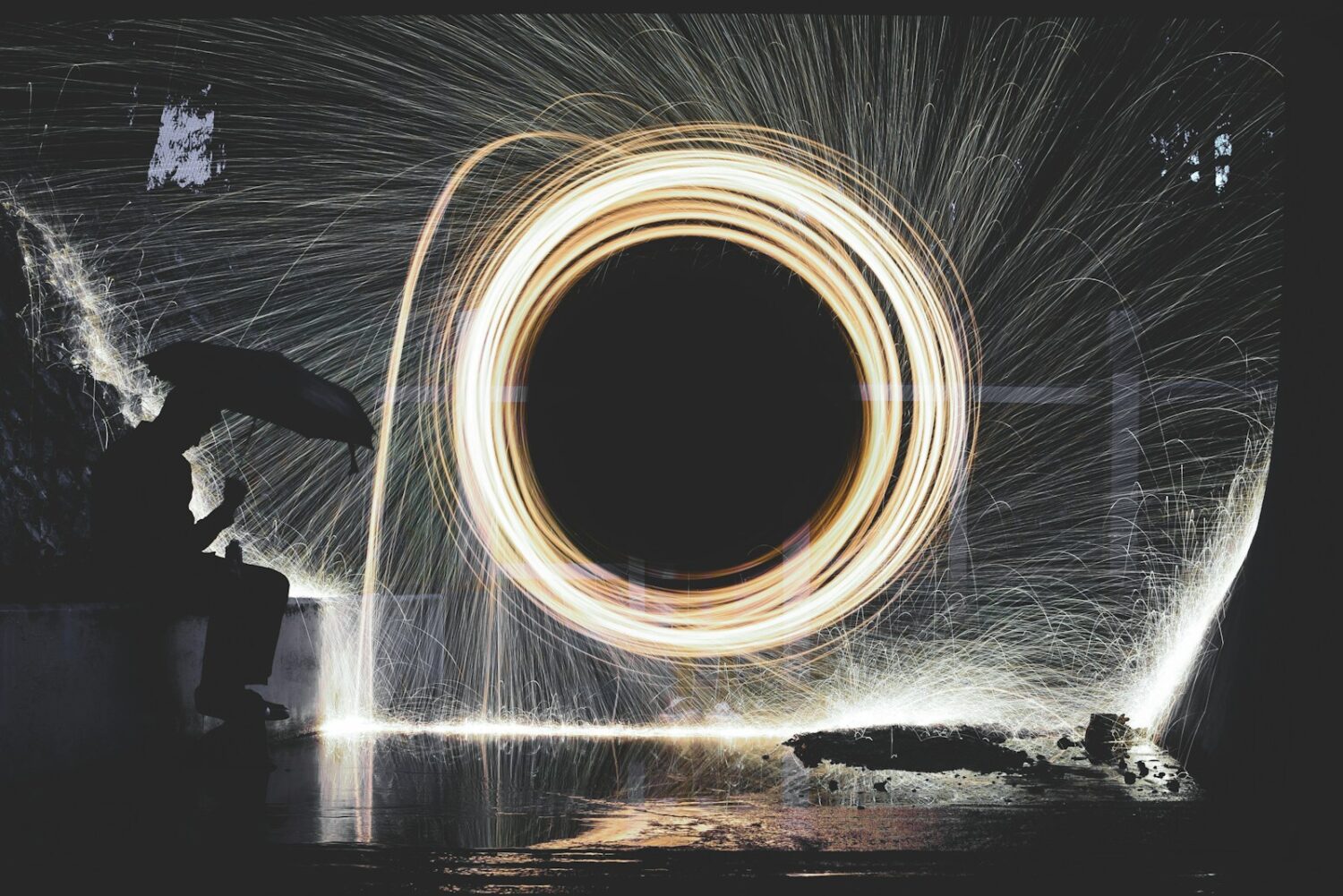A new image from the Event Horizon Telescope collaboration, which includes researchers and telescopes of the University of Arizona, has uncovered strong and organized magnetic fields spiraling from the edge of the supermassive black hole Sagittarius A*, or Sgr A*.
The Event Horizon Telescope (EHT) collaboration, which in 2022 presented the first image of Sagittarius A*, the black hole at the center of our Milky Way, has captured a new view of the massive object, this time in polarized light. For the first time astronomers have been able to measure polarization, a signature of magnetic fields, this close to the edge of the black hole. The lines mark the orientation of polarization, which is related to the magnetic field around the black hole’s shadow. Image credit: EHT Collaboration
Seen in polarized light for the first time, this new view of the monster lurking at the center of our Milky Way galaxy has revealed a magnetic field structure strikingly similar to that of a much more massive black hole, known as M87*, at the center of the M87 galaxy, suggesting that strong magnetic fields may be common to all black holes. This similarity also hints toward a hidden jet in Sgr A*. The results were published on March 27 in the journal The Astrophysical Journal Letters.
Scientists unveiled the first image of Sgr A*— which is approximately 27,000 light-years from Earth – in 2022, revealing that while the Milky Way’s supermassive black hole is more than a thousand times smaller and less massive than M87’s, it looks remarkably similar. This made scientists wonder whether the two shared common traits outside of their looks. To find out, the team decided to study Sgr A* in polarized light. Previous studies of light around M87* revealed that the magnetic fields around the black hole giant allowed it to launch powerful jets of material back into the surrounding environment. Building on this work, the new images have revealed that the same may be true for Sgr A*.
Boris Georgiev, an EHT postdoctoral researcher at UArizona’s Steward Observatory and co-author on the study, said: “The consistency of magnetic field structures around Sgr A* and M87* suggests that the processes by which black holes feed and eject jets into their surroundings may be universal, despite their vast differences in size and mass.”
“What we’re seeing now is that there are strong, twisted and organized magnetic fields near the black hole at the center of the Milky Way galaxy,” said Sara Issaoun, NASA Hubble Fellowship Program Einstein Fellow at the Center for Astrophysics | Harvard & Smithsonian and co-lead of the project. “Along with Sgr A* having a strikingly similar polarization structure to that seen in the much larger and more powerful M87* black hole, we’ve learned that strong and ordered magnetic fields are critical to how black holes interact with the gas and matter around them.”
Light is a moving oscillation of electric and magnetic fields that allows us to see objects. Sometimes, light oscillates in a preferred
orientation, also known as polarized. Although polarized light surrounds us, to human eyes it is indistinguishable from “normal,” or non-polarized, light. In the plasma around these black holes, particles whirling around magnetic field lines impart a polarization pattern perpendicular to the field. This allows astronomers to see in increasingly vivid detail what is happening in black hole regions and map their magnetic field lines.
“By imaging polarized light from hot glowing gas near black holes, we are directly inferring the structure and strength of the magnetic fields that thread the flow of gas and matter that the black hole feeds on and ejects,” said Angelo Ricarte, Harvard Black Hole Initiative Fellow and project co-lead. “Polarized light teaches us a lot more about the astrophysics, the properties of the gas and mechanisms that take place as a black hole feeds.”
But imaging black holes in polarized light isn’t as easy as putting on a pair of polarized sunglasses, and this is particularly true of Sgr A*, which is changing so fast that it doesn’t sit still for pictures. Imaging the supermassive black hole requires sophisticated tools above and beyond those previously used for capturing M87*, a much steadier target. Dan Marrone, EHT co-principal investigator and a co-author of the paper who is a professor of astronomy at Steward Observatory, and his team developed instruments that detected the polarized radio waves for this result.
“Similar to the way that polarized light can tell us the orientation of the surface it is bouncing off of, such as windows or roads, it can also show us the orientation of magnetic fields around black holes,” Marrone said. “Because the magnetic fields change rapidly around Sgr A*, turning EHT observations into polarized images was a huge challenge. We’re really proud that our data carries enough information.””
Scientists say they are excited to have images of both supermassive black holes in polarized light because these images, and the data that come with them, provide new ways to compare and contrast black holes with different sizes and environments. As technology improves, the images are likely to reveal even more secrets of black holes and their similarities or differences.
“These findings help us improve our computer models and theories and give us a better idea of what happens to matter close to a black hole’s event horizon,” added co-author Chi-kwan Chan, a UArizona professor of astronomy who focuses on theoretical modeling of black holes.
The EHT has conducted several observations since 2017. Each year, the images improve as the EHT incorporates new telescopes, larger bandwidth and new observing frequencies.
“We are developing hardware and software to automate EHT observations, thereby enabling the EHT to make more frequent observations in the future in order to capture movies of black holes,” said Amy Lowitz, an EHT research scientist at Steward Observatory who leads the EHT Agility Project.
Such observations, spanning several months, are one of the primary objectives for the EHT for the coming years, according to Remo Tilanus, a UArizona professor and the EHT operation manager who oversees the observation campaigns and technical developments.
“With the capabilities of the Agility Project, we should be able to see material swirling around M87* and being ejected into its jets,” Tilanus said.
Planned expansions for the next decade will also enable high-fidelity movies, may reveal a hidden jet in Sgr A* and will allow astronomers to observe similar polarization features in other black holes. There are even plans in the works to extend the EHT into space, providing much sharper images of black holes and enabling much more powerful studies of black hole rotation and the mechanisms that power black hole jets.
The EHT is scheduled to observe Sgr A* again in April, keeping the EHT UArizona team busy. Together with Lowitz and Georgiev, postdoctoral researcher Andrew Thomas West and graduate student Jasmin Washington are currently preparing the Submillimeter Telescope on Mount Graham and the 12-meter radio telescope of the Arizona Radio Observatory on Kitt Peak for the upcoming observation.
Washington, who participated in the 2021 observing campaign as a first-year graduate student, said she enjoyed the experience and is excited to be able to return this year.
“We’ll be observing with more telescopes than ever before, giving us better coverage and more sensitivity to make these polarized measurements,” she said.
West added: “Measuring with very high fidelity how these sources have changed since they were last observed will inform our models and allow us to answer fundamental questions about the physics in these extreme environments – it is very exciting!”











